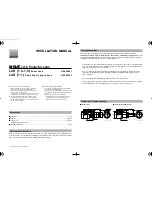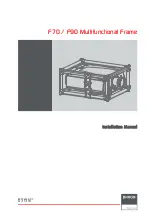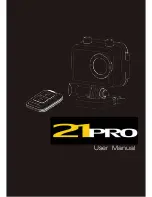
o
If taking photographs in the manual shooting mode, exposure settings should be slightly
adjusted in order to compensate for the light absorbed by the color correction filter.
This can be done by using slightly larger apertures or slower shutter speeds.
o
If making use of the camera manual white balance function, it is important to measure
white every time the filter is installed or removed from the housing lens port.
Alternatively, measured values can be stored in any of the customized shooting modes
of the camera (U1, U2 or U3) for quick and easy adjustment whenever installing or
removing the filter.
o
Note that when a color correction filter is installed, making use of a flash will result with
reddish images in most compositions, due to overcompensation for loss of red colors
underwater. It is therefore recommended to either turn off the flash or to manually
adjust colors with the camera when making use of a color correction filter.
10.
What should I consider when mounting a BigEye Wide Angle Lens on the FP7100?
a.
There are a few techniques that should be followed in order to avoid a lens flare, which
is often encountered when using dome ports of any kind due to the reflection of the sun
or strobe:
i.
Make sure that the wings of the BigEye Lens are positioned at an angle that
blocks the strobe output, as well as the sun. In order to prevent the wings from
unintentionally changing position, some friction has been added, but rotating
the wings can be easily done by following a simple technique.
Hold the wings
and push them against the housing when the BigEye Lens is mounted on your
housing lens port. At the same time, rotate them around the lens, till they have
reached the desired position.
ii.
Images in which the sun is captured can be usually taken during mornings or
afternoons, when the sun is not as strong as during the middle of the day. In
general, the sun will have a much softer and successful presence in the image
during early and late hours of the day and will also cause less of a flare.
iii.
Make sure that the strobe is not positioned towards the lens. When shooting a
nearby subject, for instance, it is better to position the strobe slightly in front of
the camera housing rather than behind it (so the light doesn't reflect on the
BigEye Lens). If you choose to position the strobe behind the camera housing,
make sure it's not pointed directly towards the lens, but slightly tilted outwards.
This will also ensure softer light and shadows in your image.
b.
When taking photos with the BigEye Lens installed, set your camera focus mode to
“MACRO”, or else the images will be pretty blurred. This doesn’t mean you should aim
for macro compositions, on the contrary – the BigEye Lens was designed for wide angle
shots and it’s perfect for shooting wrecks, coral reefs, divers, etc.
c.
During the beginning of your dive, your lens might become foggy as a result of an
increase in the air temperature inside the lens, following submersion in cooler water.
Storing the lens in a cool dry place when not being used, such as a padded housing bag
with a few silica gel packs inside, and
submerging it in cool water for 10 minutes prior to the dive, will assist in preventing
such condensation. However, even if your BigEye Lens starts fogging up at the beginning
of the dive due to temperature differences, please note that continuing to dive with it
for about 10 minutes will eventually dissolve the fog.























